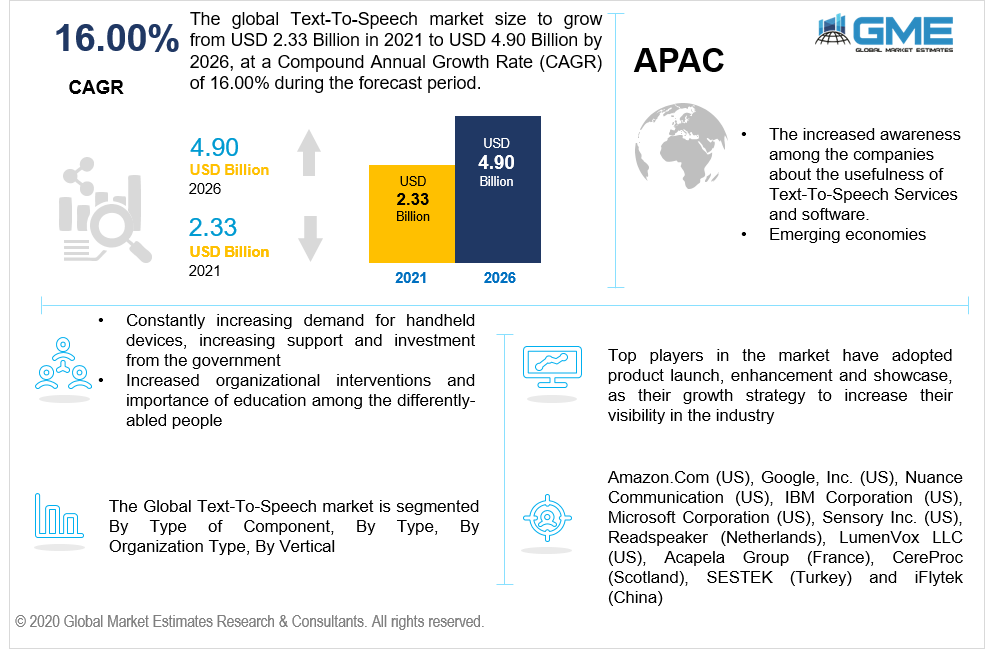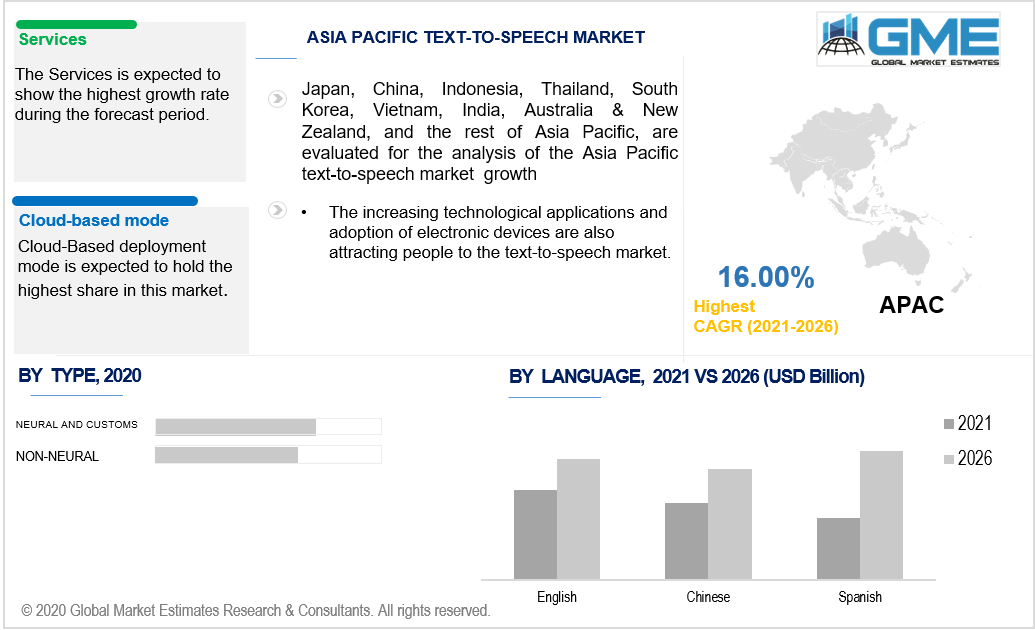
Global Text-To-Speech Market Size, Trends, and Analysis- Forecasts to 2026 By Type of Component (Software/Solution, Services [SAAS, Support, Implementation, and Consulting]), By Deployment Mode (Cloud-based, On-Premise), By Type( Non-Neural, Neural and Custom), By Organisation Type (Small and Medium Enterprise, Large Enterprise), By Language (English, Spanish, Hindi, Chinese, Arabic, Others), By Vertical (Introduction, Consumer, Automotive & Transportation, Healthcare, Education, Assistant tool for visually impaired or disabilities [Dyslexic Reader], BFSL, Retail, Enterprise, Travel and Hospitality, Others), By Region (North America, Europe, Asia Pacific, MEA, and CSA), Competitive Landscape
Text-To-Speech is a process of converting written natural language content into an audio output. This market has witnessed an upward trend over the past few years. The text-to-speech process of generating audio outcomes has opened up on various platforms, thus reaching a wide range of audiences.
Today, the population over the world has more diversity than ever. Evolving cultures are demanding a variety of literature in various languages. Text-to-speech enables the content to reach a huge chunk of the population all over the world. Although countries today are developing and reaching new heights, a massive group of people in the world population still come under the category of illiteracy. The huge illiteracy rate is not just a result of poverty or inequality within society but is also a result of various disabilities persistent among the population. Learning disabilities like ADHD and Dyslexia have gained the attention of the mass in recent years and the necessity to treat/assist the disabled community.
The Text-To-Speech market has also brought a wide scope of opportunities for disabled people, making it easy for them to explore and understand the content and enhance their daily lifestyle. Along with the disabled community, the text-to-speech platform is also enabling senior citizens to enjoy various pieces of literature available today through audio outputs.
Nowadays, the population of migrating students has also increased. Expanding education and university culture has widened the scope for students to pursue education from institutes in different countries. Although, with various language modes of education, students face difficulties adapting to new languages. The text-to-speech market has eased this issue for students through audio content available in all languages.
Increasing demand for handheld devices, increasing support and investment from the government, increased organizational interventions, the importance of education among the differently-abled people, increasing technological advancements, increasing usage of digital content, and rising learning disabilities among children are expanding the text-to-speech platform in the world market.
Irrespective of these factors boosting growth in the market, the complexities in generating appropriate pronunciations for synthesized speech may cause restraints in the growth of this Text-To-Speech Market.

The text-to-speech conversion is supported by the Software/Solution and the Services (SAAS, Support, Implementation, and consulting) components. The audience has been preferring text-to-speech services compared to software. The sub-domain in the service component like SAAS enables the audience to take the benefits of the market over the internet instead of following the complex installation procedures of software. Services are an essential part of the text-to-speech model for easy functionality. Services are the key components and fundamental step in providing smooth deployment modes. Companies in the Text-To-Speech market prefer services to quickly adapt to the new emerging audio content.
The text-to-speech service is available for the user base through two deployment modes, namely the cloud-based and on-premise modes. The cloud-based deployment model is more preferred and beneficial for the service providers over the on-premise deployment model. Cloud-based deployment eases out the process of maintaining and managing the IT infrastructure for the service providers. This deployment mode also facilitates improved service, improved IT interventions, scalability, security, and consistency. SaaS application by the companies has also accelerated the demand growth for cloud-based deployment model in the Text-To-Speech market.
Neural and Custom voice in the text-to-speech market enables the providers and the audience to customize their voice or audio conversions as per their requirements. Neural and Custom type has more acceptance and usage among the audience owing to its ability to provide a user-friendly experience, natural humanlike audio tone quality, and engaging experience.
Large enterprises hold their dominance attributing to their ability to add more investments and technological upgrades into the services provided. Large enterprises have been the prominent adopters' text-to-speech servicers. The increasing demand and awareness about the importance of text conversions into audio outputs in today's world are encouraging competition among these enterprises. These large enterprises also promote the importance of enabling the disabled community to have experience and learn various works of literature.
Although, with increasing demand and considerably few service providers, the Small and Medium enterprises are also getting a scope to come into the market and provide their services to the end-users. The availability of cloud-based services at considerably convenient prices enables SMEs to showcase/market their services easily to the audience.
Considering the diversity of languages in the world, it becomes necessary for text-to-speech service providers to deliver audios in different languages. The text-to-speech generation is available in English, Spanish, Hindi, Chinese, Arabic, and other languages. English language, being used majorly by the world population, is preferred the most by the text-to-speech market enterprises. Mass student population from China, migrate to various other countries for higher education and job search. This leads to high demand for text-to-speech conversions in the Chinese language.
With gaining popularity, the Spanish language is also in high demand in the text-to-speech market.
Text-to-speech conversions are of huge help in Introduction, Consumer, Automotive & Transportation, Healthcare, Education, an Assistant tool for visually impaired or disabilities [Dyslexic Reader], BFSL, Retail, Enterprise, Travel and Hospitality, and Other verticals. Consumers today have highly adopted themselves to technology, smartphones, and other electronics, for personal use and support. This has tremendously increased their usage of text-to-speech services.

The Text-To-Speech market is dominated by North Americans due to its ability to provide high-tech speech software and services to the end-users. This region also experiences constant support from governmental bodies to encourage education and speech assistance to disabled citizens.
Text-to-Speech services have also gained high popularity among the crowd of the Asia-Pacific region. The APAC region has now set its feet into the technology-driven market of Artificial Intelligence and IoT. This is enabling voice-service providers to reach out to their huge audience with ease and satisfy their requirements. Also, the increasing awareness among the citizens about the importance of education for the differently-abled is boosting the demand for text-to-speech market software and services. The application of text-to-speech service in various verticals is also attracting a mass population thus witnessing higher growth rates.
Amazon (US), Google, Inc. (US), Nuance Communication (US), IBM Corporation (US), Microsoft Corporation (US), Sensory Inc. (US), Read speaker (Netherlands), LumenVox LLC (US), Acapela Group (France), CereProc (Scotland), SESTEK (Turkey) and iFlytek (China) among others, are some of the industry players. Other key players in the text-to-speech market include Baidu, Inc. (China), Facebook Research (US), TextSpeak (US), Govivace (US), Nextup Technologies (US), iSpeech (US), Nexmo Inc. (US), and GL Communications (US).
Please note: This is not an exhaustive list of companies profiled in the report.
In September 2020, Nuance Communications signed a partnership with Rakuten Mobile, Inc. This gave both the companies the right to leverage Nuance Intelligent Engagement AI Services and Rakuten Communications Platform (RCP).
We value your investment and offer free customization with every report to fulfil your exact research needs.
The Global Text-To-Speech Market has been studied from the year 2019 till 2026. However, the CAGR provided in the report is from the year 2021 to 2026. The research methodology involved three stages: Desk research, Primary research, and Analysis & Output from the entire research process.

The desk research involved a robust background study which meant referring to paid and unpaid databases to understand the market dynamics; mapping contracts from press releases; identifying the key players in the market, studying their product portfolio, competition level, annual reports/SEC filings & investor presentations; and learning the demand and supply-side analysis for the Text-To-Speech Market.

The primary research activity included telephonic conversations with more than 50 tier 1 industry consultants, distributors, and end-use product manufacturers.

Finally, based on the above thorough research process, an in-depth analysis was carried out considering the following aspects: market attractiveness, current & future market trends, market share analysis, SWOT analysis of the company and customer analytics.

Tailor made solutions just for you
80% of our clients seek made-to-order reports. How do you want us to tailor yours?
OUR CLIENTS